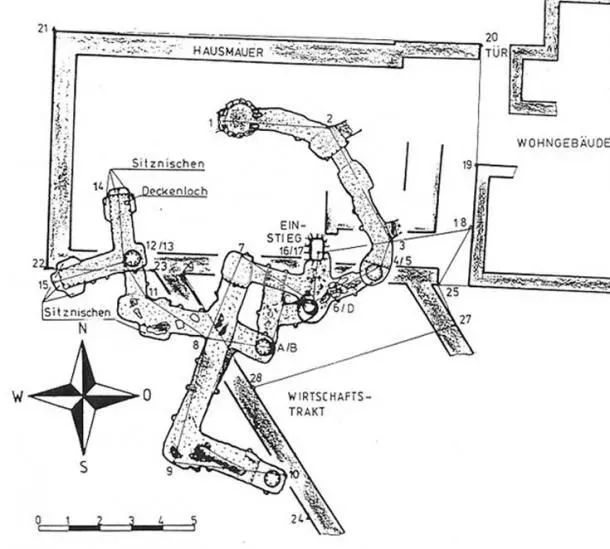Erdstall is a type of tunnel found throughout Europe, mainly in the southeastern part of Germany, Bavaria and Austria. This underground network dates back to the Stone Age and is 12,000 years old. The archaeological evidence is so slim that even age determination is difficult.
Airstalls are believed to have been created during the Middle Ages, although some argue that these tunnels date back to the Stone Age.
At present, no one knows exactly why these structures were created at all. Proponents of the idea that erdstalls date back to the Stone Age believe that these structures are a network of underground passages stretching from Scotland to Turkey.
The word “erdstall” is borrowed from the German language and can be roughly translated as “earth stall” or “mine tunnel”. Although various types of underground tunnels are known around the world, erdstalls have certain features that distinguish them from other underground tunnel systems.
In general, the erdstall network consists of very low and narrow tunnels, which are usually oval in shape and arranged either vertically or horizontally. It has also been found that these tunnels typically extend between 20 and 50 meters.
Another unique feature of the erdstall is the “schlupf” (meaning “to slip out”). These are extremely narrow openings (usually only 40 cm in diameter) that serve as transition points between tunnels located at different heights.
Currently, about 2000 erdstalls are known in Europe. Most of these are located in the German state of Bavaria, where it is estimated that at least 700 such tunnel networks exist. In neighboring Austria, you can find about 500 more of them. Similar underground passages have also been found in countries such as Britain and France.
A typical tunnel is very low requiring an adult human to walk in a hunched position, but some are so small that explorers have to get down on all fours.
Some tunnels have more than one level with a tight passageway, known as “schlupfe” or “slip”, connecting the higher tunnel with the lower one.
But the passages are so tight that an average person needs to crawl under the slip hole, stand up thereby sliding the shoulders through the uncomfortably tight hole, and squeeze his way out and into the higher tunnel.
A schlupfe can also occur horizontally connecting two tunnels in the same level.
The purpose for which the erdstall were built is still a big mystery. For some locals, these underground tunnels are associated with legendary creatures such as elves or dwarves who are said to have built them or are believed to live in them. In some places, erdstalls have been given fanciful names reflecting their association with local folklore.
Among them are “Shrazelloch” (“goblin’s hole”) and “Alraunenhöle” (“mandrake cave”). Others suggest that erdstalls were associated with castles and served as secret escape routes, as mentioned in some sagas. However, the problem with this interpretation is that erdstalls are known to have only one entry and exit point, making them unsuitable for this purpose.
Others suggest that the tunnels were used as hiding places. However, the narrowness of these passages, combined with the fact that there is practically no air currents in them (due to the only entrance and exit), would make them a rather inconvenient and unpleasant shelter. Another suggestion is that they were used to store things.
Again, the narrowness of these tunnels makes them impractical for this purpose. In addition, many erdstalls are below the waterline and have been known to fill with water from time to time, especially during the winter. Therefore, it is unlikely that erdstalls were used for storage purposes.
Some speculates that these early Christian missionaries also brought along heathen ideas, the remnants of Druid scholarship or special Celtic concepts of the afterlife, which led to the construction of the subterranean galleries.
But it was possible that the tunnels were also prisons for demons, evil dwarves and the undead. But not everyone finds these spiritual interpretations convincing.
One of the strangest claims about them is that they are part of a vast, interconnected network of underground passages that stretch from Scotland in the west to Turkey in the south.
Moreover, this underground network is said to have originated as early as the Stone Age and is 12,000 years old, much older than the generally accepted estimate that they date back to the Middle Ages.
It has even been claimed that these tunnels functioned as a kind of “ancient underground highway” that allowed people to move safely from one place to another, regardless of what was happening above ground.
There are various problems associated with this theory. For example, even though there are thousands of erdstalls, they are not really related to each other. Another point is that although large underground cities have been discovered in Turkish Cappadocia, they are very different from European erdstalls.



